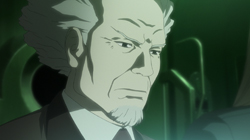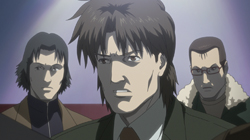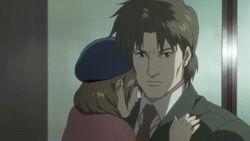Behind the Scenes Part 10: Kenji Kamiyama (Director)
In this tenth and last interview, we couldn't but invite Kenji Kamiyama, the director of the movie, who certainly does not need introduction.
Part 10: Kenji Kamiyama (Director)
"We consider this project as a sort of badge of honor."
 | Profile Director and scriptwriter. Born in Saitama Prefecture on March 20, 1966. In 1985 he joined the background atelier Studio Fuga. A rare example of a background artist shifting to directorial roles, Kamiyama worked as sequence director in Jin-Roh (1999) and wrote the script for Blood: The Last Vampire (2000), then debuted as director in MiniPato (2002). International attention eventually arrived with the TV series Ghost in the Shell: Stand Alone Complex (2002) and Ghost in the Shell: S.A.C. 2nd Gig (2004), followed by the feature-length Ghost in the Shell: Stand Alone Complex - Solid State Society (2006). In 2007, after almost 6 years in the world of SAC, Kamiyama directed the high-fantasy TV series Guardian of the Spirit. In 2006 he 'acted' as a superlivemation digital puppet in Mamoru Oshii's Tachigui: The Amazing Lives of the Fast Food Grifters, in the role of Manager Kamiyama. |
What were your thoughts after finishing Stand Alone Complex - Solid State Society?
For this special chapter of Stand Alone Complex, we spent an entire year and a budget totaling 360 million yen (about US$3.4 million), which is about the amount usually spent for a feature film. The S.A.C. series started in 2002 - actually even earlier, if you count the planning and pre-production period. At that time, I was still a novice director, so I thought I'd be happy if this series could serve as an opener for Director Oshii's feature film Innocence, which was in production at the same time. And I thought it would be an honour just to have the series' DVD to be placed in a small corner of the section dedicated to Mamoru Oshii's works in video stores. That was my feeling when I started. But one good thing about a TV series is that since it unfolds across a wider time-span, it progressively captures more and more fans, and allows the staff to develop stories as we could not otherwise in a single feature film. Eventually, staying with this project all these years has turned out as a very rewarding experience.
Starting from myself, all the staff has the greatest respect for the world of Ghost in the Shell, so we have been very cautious not to degrade this name. Stand Alone Complex - Solid State Society was not originally made for theatres, but I think it was because of our years of hard work that made its screening at the 19th Tokyo International Film Festival and other film festivals overseas possible. I am very honored to be the representative of the production staff. And I am so proud that we were able to produce a series that's been loved for so long.
Have you ever felt it difficult to make a sequel to S.A.C. 2nd Gig?
To tell you the truth, when I completed S.A.C. 2nd Gig, I felt I had done everything I wanted to do. So I wasn't really confident about doing a sequel when I started working on the script. I was wondering whether I could actually make a sequel, or whether the fans were really waiting for it, and all that sort of thing.
But as we proceeded into the production, I came to realize that the audience, staff and the people who were associated with this project were looking forward to my next challenge with the world of GITS: SAC. Of course there was no question about my motivation to make a new anime, but what really moved me while working on Solid State Society was this strong sense of gratification in being aware that we were creating something that was highly anticipated by those people around us. Even though it was not intended for theatrical release, this was my first challenge with an over 100-minute long anime, so the production staff and I had some very difficult times, but everyone really gave his and her best. I am so grateful and I feel we have produced something that is going to stay in terms of quality and storytelling.


Solid State Society was produced two years after 2nd Gig, and in the SAC timeline, the movie itself is set 2 years after the last episode of 2nd Gig. We can see that the leading characters had gone through a minor change in their relationships. What do you think are the key points to remember in S.S.S?
The anime characters are not real actors, so you would expect them to move as I, the director, wish them to. Furthermore, they are not supposed to get older ever. But after working with the same characters for six years, they began to go out of control. I mean they actually gained "ghosts," i.e. the human souls. The members of Section 9 had moved on, so that they didn't allow themselves to stay in the same moment in time over and over as is the case with popular family entertainment anime characters. Actually, when I completed 2nd Gig, I regretted not being able to bring Motoko's emotional state back to the cheerful one you can see in the original Shirow Masamune's comic book. So that became my goal in Solid State Society. But as I worked on the script, I found myself at the latter part of the story, with no more time left, and Motoko apparently still unwilling to decide to go back to Section 9.
My mentor Mamoru Oshii taught me one important truth: "as you keep working with a story, you gradually realize that it becomes impossible to control the characters." I never dreamed I'd experience that myself, so I was happy, but also sad at the same time when I actually encountered that moment. It was exactly as he told me and I felt Kusanagi was telling me, "If you are going to return me to Section 9, then you must make a convincing story." And then, just seven minutes before the end title, I felt that I finally accomplished the goal I set out, i.e. to put Kusanagi and Section 9 back to almost where the first season started. Even at that point, Kusanagi didn't say she wanted to return. At the same time, I think that we have succeeded in depicting the maturation process of Section 9 after two years and a full-scale reorganization in a real and credible way.
For the incidents occurring in S.S.S., you've chosen topics that come directly from our present times, such as the aging society and child abuse. What was the reason behind choosing these topics?
As a matter of fact, in the entire Stand Alone Complex series, we have often taken up actual social issues and incidents, so in a way we just stuck at an established "tradition." But there's another reason. My mentor Mamoru Oshii's feature film, Innocence, also dealt with kidnapping. However, although that was the theme of the movie, the story didn't necessarily cover the actual kidnapping of real humans, but inclined toward telling the story of the "containers" they were dubbed into. I had my own ideas, I mean I felt it was about time to grow away from my mentor... I felt I had to give back something to the director too, but Innocence sort of stood in my way. So I decided to present my own idea. That was my first motivation to take up kidnapping as my theme. Basically, I think S.S.S. is the most actual and political of all the S.A.C. installments. And at the same time, I am confident that S.S.S. has extensively portrayed the human drama to the maximum that the S.A.C. series could offer.


How do these themes connect to the title, Solid State Society?
I was conscious of the double meaning of the words. I have used the word transistor (a solid-state device) as a metaphor of the elderly - there is actually a line in the story that tells of this. So the title means a society where elderly people lived, but at the same time I made it a society that had already deteriorated (device-oriented.) I tried to insert a message that we should get back to a society where people were conscious of and caring about others.
Lastly, could we have your message for the fans?
S.S.S. is the materialization of the appraisal received by the staff for the Stand Alone Complex series, and the culmination of 6 years of hard work. We consider this project as a sort of badge of honor. I am especially indebted to chief animation director Takayuki Goto. He was the spiritual backbone of the animation team, and instilled souls to the characters in the film. He checked all of the cuts attentively - more than 1200 of them - all alone. His titanic efforts greatly contributed to bring S.S.S.'s quality to a theatrical feature film level. We have spent one full year and gave all our energy to it. Hope you will enjoy it.
© 2002-2006 Shirow Masamune - Production I.G/KODANSHA

![WORK LIST[DETAILS]](/contents/works/design/images/left_title.gif)



 terms of use
terms of use